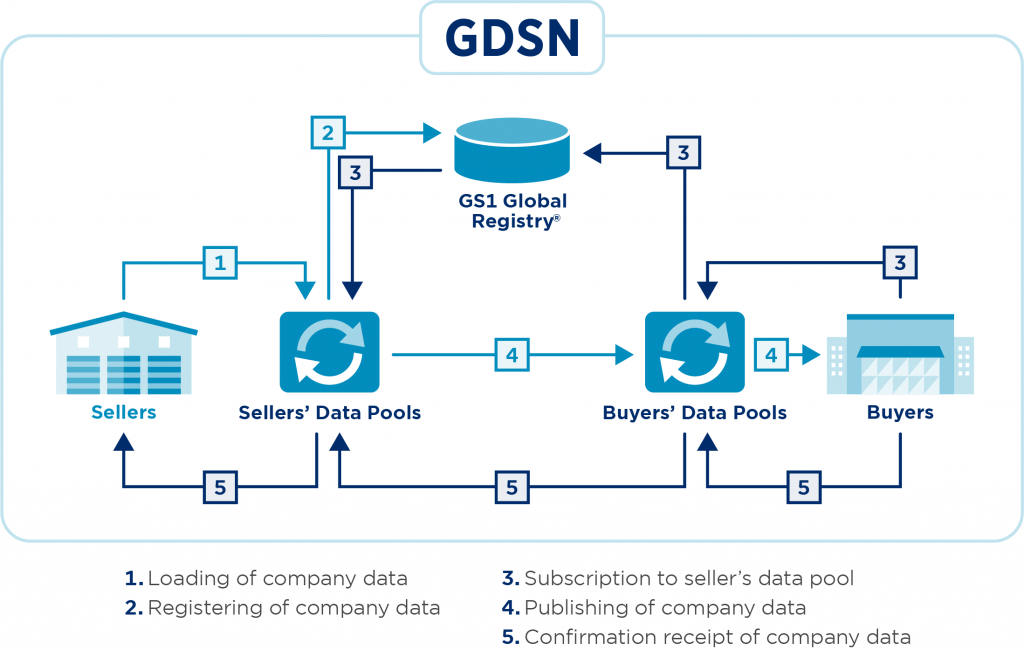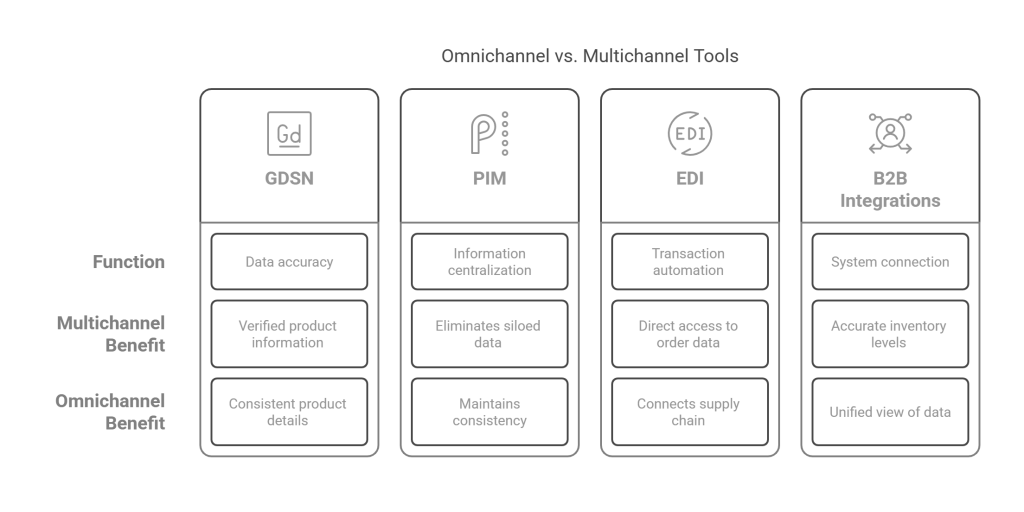Introduction
Product transparency is now a make-or-break factor for consumers, with 63% of customers wanting to shop elsewhere after just one bad experience with a brand. This shift in consumer behavior isn’t surprising when we consider how thoroughly today’s shoppers research their purchases.
84% of consumers consider the product content experience vital to their purchasing decisions, while 81% are ready to switch to brands offering more comprehensive information on product pages. Furthermore, 96% of shoppers search multiple items before making significant purchases, and 98% research products online before visiting physical stores. Consequently, reliable and consistent product data has become increasingly important for creating seamless omnichannel experiences.
What’s particularly concerning for brands is that product information is now one of the least trusted sources of data—ranking below politicians, social media influencers, and even bank managers. However, by 2030, detailed product information will be the most in-demand feature from customers. In this blog, we’ll explore why product transparency guidelines are important in 2025, how the Global Data Synchronization Network (GDSN) facilitates sustainable product transparency, and what steps brands can take to establish lasting consumer trust through transparent practices.
Key Takeaways
- Consumer expectations have skyrocketed: 76% of shoppers now consider transparency extremely important, up from 69% in 2018, making it a non-negotiable business requirement.
- GDSN delivers measurable results: Brands using the Global Data Synchronization Network report 25% fewer data errors and 30% increased operational efficiency through automated, standardized product information sharing.
- Inconsistent data kills sales: 50% of consumers abandon purchases due to insufficient product information, while 83% leave websites lacking comprehensive content entirely.
- Transparency drives loyalty: An impressive 94% of consumers show greater loyalty to transparent brands, with 56% claiming complete transparency makes them “loyal for life.”
- Omnichannel consistency is crucial: With 84% of consumers researching online before visiting stores, brands must ensure identical product information across all touchpoints to maintain credibility.
What is Product Transparency and Why It Matters in 2025
Product transparency represents the open and honest sharing of information about products, practices, and policies. Specifically, it encompasses everything from ingredient lists and sourcing details to manufacturing processes and company values.
Defining Product Transparency in Modern Retail
Product transparency involves providing a comprehensive and honest depiction of products that addresses customer needs and showcases why consumers should choose them.
According to industry experts, it’s best defined as “a complete list of ingredients” that demonstrates truthfulness about what goes into products. Beyond ingredients, it includes openly sharing information about supply chains, business practices, and pricing strategies to enable informed purchasing decisions.
Unlike traditional marketing, modern product transparency isn’t a one-time effort but a continuous commitment throughout a product’s lifecycle. This approach provides measurable data that guides brands in creating offerings that genuinely resonate with their target audience.
How Consumer Expectations Have Evolved
Consumer demand for transparency has steadily increased in recent years. The percentage of shoppers considering transparency extremely important rose from 69% in 2018 to 76% in 2023. This growing importance is primarily driven by millennials and shoppers with children.
Today’s consumers expect brands to be forthcoming about:
- Detailed nutritional information
- Sourcing practices
- Ingredient lists
- Sustainability information
Moreover, 55% of shoppers now express interest in seeking information beyond what appears on labels—up from 50% in 2021. Additionally, 82% report they’re likely to seek more details by scanning product QR codes.
The Link Between Transparency and Brand Trust
Transparency has truly become “the currency of trust” in the food industry. A remarkable 94% of consumers are more likely to show loyalty to brands that offer complete transparency, with 56% claiming such transparency would make them “loyal for life”.
As a result, brands embracing information sharing are winning the trust game. This trust directly impacts business outcomes—90% of millennial respondents would support a brand they see as purposeful. Similarly, 45% of Gen Z shoppers engage more with brands they perceive as trustworthy.
Beyond loyalty, transparency reduces skepticism and creates authenticity that resonates with today’s discerning consumers.
How GDSN Enables Accurate and Consistent Product Data
The backbone of today’s product transparency efforts lies in technology that ensures data accuracy. The Global Data Synchronization Network (GDSN) stands at the forefront of this revolution as the world’s largest product data network.

What is GDSN and How it Works
Essentially, GDSN is an automated, standards-based global environment enabling secure and continuous data synchronization. This interconnected network of interoperable data pools allows trading partners to exchange standardized product master data worldwide. Through a publish-subscribe pattern, GDSN connects manufacturers, distributors, and retailers via data pools where each product receives an identification code containing all relevant details—from color and size to weight and shipping logistics.
Core Benefits of GDSN
1. Real-Time Data Sharing Across Trading Partners
One significant advantage of GDSN is its ability to upload, maintain, and share high-quality product content automatically. This network ensures trading partners have immediate access to current and complete information needed for both local and global markets. Real-time data synchronization empowers suppliers to update product content instantly for all trading partners, creating what amounts to a universal language between retailers and distributors.
2. Reducing Errors and Manual Updates
Before GDSN implementation, businesses struggled with data inconsistencies. Currently, companies using GDSN report a 25% reduction in data errors and a 30% increase in operational efficiency. Since information is input directly through data pools, the same data is shared across all channels, drastically reducing entry and edit errors. This standardization simplifies adoption while maintaining data integrity.
3. Ensuring Product Label Transparency
The GDSN helps brands provide comprehensive data so consumers know exactly where their purchases come from. All data entered into pools undergoes testing and validation to meet various standards and regulatory requirements. Commport GDSN Datapool, a GS1 Certified GDSN Datapool since 2005, is trusted by over 3000+ brands to facilitate this crucial data exchange.
Throughout the supply chain, GDSN promotes product label transparency by ensuring every barcode scan reveals complete product details—giving consumers confidence that their shopping choices align with their values.
The Role of Transparency in Omnichannel Consumer Behavior
Modern shopping journeys cross multiple touchpoints, making product transparency throughout these interactions critical for brand success.

Why Consistent Product Data Matters Across Channels
Omnichannel retail aims to create a seamless shopping experience by connecting online and offline channels. Throughout a typical purchase journey—discovering products on social media, researching on websites, and buying in-store—shoppers expect identical product information at each step. Inconsistencies between these touchpoints lead directly to confusion and disappointment.
Notably, if customers find conflicting details about specifications or pricing, they immediately question the retailer’s reliability. This doubt often becomes a deal-breaker, prompting them to abandon the purchase altogether.
How Consumers Research Products Before Buying
An impressive 84% of consumers research online before visiting physical stores, highlighting the necessity of comprehensive digital product information. Beyond basic research, there’s been a significant increase in deal-hunting behavior—50% of shoppers searched for the best deals in 2025 compared to 40% in 2024.
Impact of Poor Product Content On Sales
Incomplete product content directly harms revenue. Half of all respondents have abandoned potential purchases because they couldn’t find sufficient information. Even more concerning, 35% returned products that didn’t meet expectations based on pre-purchase content.
Currently, 83% of shoppers will leave a website lacking comprehensive content, and 73% think less of brands providing inaccurate information—an 11% increase from just one year prior.
Product Transparency Reporting in Digital Retail
Transparency reporting occurs when manufacturers disclose detailed product information, including chemical identities. This practice yields tangible benefits: fewer customer service requests, increased consumer confidence, reduced regulatory risks, and typically safer products.
Ultimately, modern shoppers expect both accuracy and consistency across platforms. With 62% of online shoppers globally refusing to buy from brands with incorrect product data, transparency has become non-negotiable for success in today’s retail landscape.
Building Long-Term Trust Through Transparency and GDSN
Trust forms the cornerstone of successful brand-consumer relationships in 2025. First and foremost, businesses implementing transparent practices see tangible results in customer retention and growth.
How Transparency Drives Customer Loyalty
An impressive 94% of consumers are more likely to remain loyal to brands offering complete transparency. Beyond just occasional purchases, transparency creates lifetime customers—with 73% of consumers considering it an extremely important factor in their overall experience. Indeed, brands that prioritize honest communication build stronger relationships that translate into repeat business and positive word-of-mouth recommendations.
Sustainable Product Transparency and Traceability
Traceability provides end-to-end visibility throughout the supply chain. Through GDSN, companies gain complete visibility of inventories while empowering consumers to understand where their products originate. This visibility has become crucial as sustainability significantly influences many consumers’ purchasing decisions.
Using Smart Labels and QR Codes for Deeper Engagement
Smart labels gather GDSN data to provide comprehensive product information that goes well beyond package labels. Simultaneously, QR codes offer an efficient pathway to this information, directing customers to dedicated landing pages. One international consumer products company implementing serialized QR codes saw markedly increased customer engagement and simplified its rewards redemption process.
Conclusion
Product transparency has emerged as a fundamental element of business success rather than just a marketing tactic. Consumers now demand complete information about what they purchase, with a striking 76% considering transparency extremely important. GDSN stands at the center of this transformation, enabling brands to share accurate, consistent product data across all channels and touchpoints.
Trust builds gradually but can shatter instantly. Brands that commit to transparency through GDSN implementation gain substantial advantages—reducing data errors by 25% while increasing operational efficiency by 30%. This accuracy directly translates to customer loyalty, as 94% of consumers demonstrate greater allegiance to transparent brands.
The omnichannel shopping journey further underscores why consistent product information matters. Shoppers research extensively before purchasing, checking multiple sources and platforms. Any inconsistency between these touchpoints prompts immediate skepticism, often resulting in abandoned purchases.
Looking ahead, product transparency will only grow more critical. Technologies like SmartLabel and QR codes already provide deeper engagement opportunities, allowing consumers to access comprehensive information beyond what fits on packaging. Brands that embrace these tools alongside GDSN implementation position themselves for sustainable growth built on authentic consumer relationships.
The message becomes clear—product transparency represents both an ethical responsibility and a business imperative. Brands that prioritize honesty, consistency, and accessibility of product information will thrive in 2025 and beyond, while those clinging to opacity risk becoming increasingly irrelevant to today’s discerning consumers.
Commport GDSN Datapool
Download: GDSN Buyers Guide
Empower your business with global data synchronization; download our GDSN Buyer's Guide today and take the first step towards streamlined, accurate, and compliant product data management.
Frequently Asked Questions
Product transparency refers to openly sharing detailed information about products, including ingredients, sourcing, and manufacturing processes. It’s crucial in 2025 because consumers increasingly demand complete honesty from brands, with 76% considering transparency extremely important for making purchasing decisions.
The Global Data Synchronization Network (GDSN) enables accurate and consistent product data sharing across trading partners. It reduces data errors by 25% and increases operational efficiency by 30%, ensuring that consumers receive reliable and up-to-date product information across all channels.
Transparency significantly influences consumer behavior, with 94% of consumers more likely to remain loyal to transparent brands. Additionally, 50% of shoppers have abandoned purchases due to insufficient product information, highlighting the importance of comprehensive and accurate product content.
In omnichannel retail, consistent product information across all touchpoints is crucial. With 84% of consumers researching products online before visiting physical stores, any inconsistency in product data can lead to confusion, skepticism, and lost sales.
Brands are leveraging technologies like SmartLabel and QR codes to provide deeper product information. These tools allow consumers to access comprehensive details beyond what’s on the packaging, facilitating greater engagement and building trust through increased transparency.





